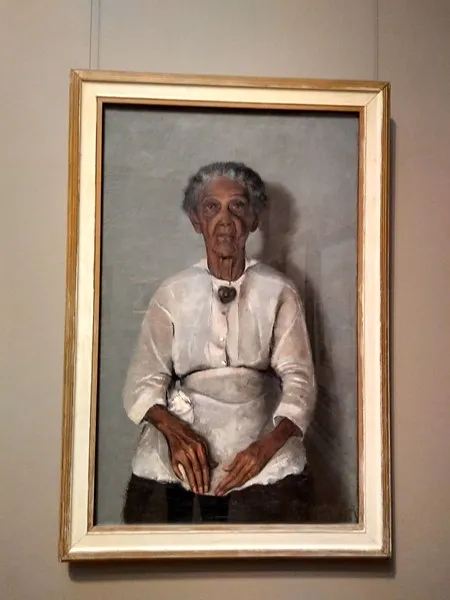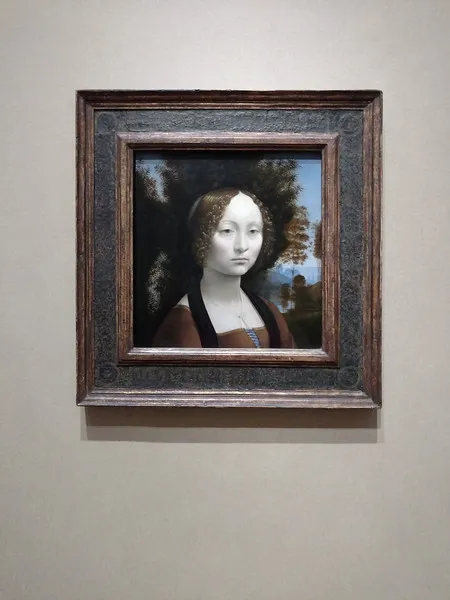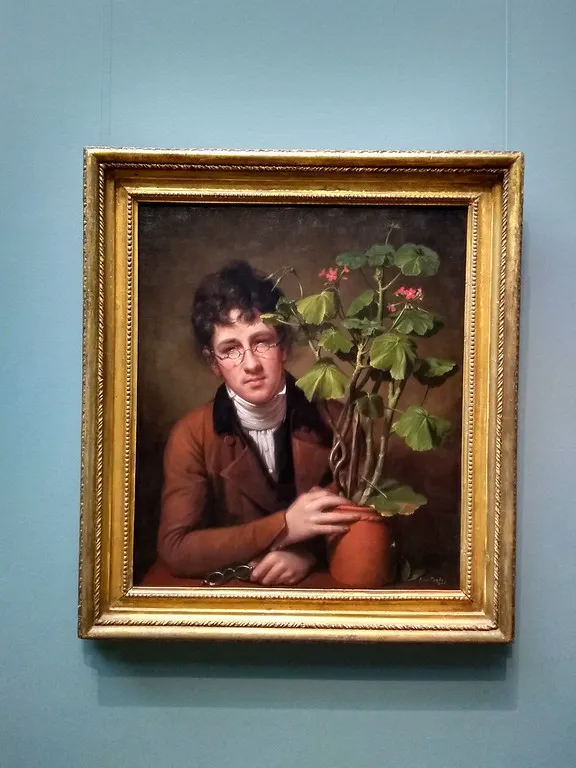For the month of July I will be highlighting the Portrait Tour (with a few changes) of the National Gallery of Art that I initially did for my friends in DC in 2005.
For this tour we will be looking at these portraits from 1500-1900.
 |  |  |
|---|---|---|
 |  |  |
If you want to see some of the other tours of the NGA that I did while living in DC they are linked below.

What is a portrait?
Can any picture of a person be a portrait?
Can you have a portrait of something that is not a person?
The Tate Gallery in London defines:
A portrait is a representation of a particular person. A self-portrait is a portrait of the artist by the artist.
An answer to this question that I really like on StakeExchange is
A portrait: Captures the personality or essence of a subject. Not just a picture with a person in it. A "clinical" portrait might not attempt to reveal the soul of a person, but it still needs to capture something of that person's uniqueness — or else it's not a portrait.

Let's begin our Portrait tour of the National Gallery of Art with one of the most famous portraits in the gallery and one of my favorites!

Leonardo da Vinci
Ginevra de Benci, 1474/1478
Painted in the late 1400s in Italy by Leonardo da Vinci this is a wonderful portrait of Ginevra de Benci around her marriage when she was 16 years old.
While this might just look like a good painting when you see other paintings at the time you see the genius of Leonardo and his skill with oil paints.
He also used a lot of symbolism to capture Ginevera's personality. For instance, her high hair line, which they used to pluck shows her intelligence, the blue thread shows her family has some money yet in looking closer you see it is tread bare at the end signifying her thrift. The juniper tree behind her is a symbol of her chastity.
In looking at her what do you see? A serious, almost sad young woman? Someone that takes care of herself. A lady in which you want to know what she is thinking.

For this next portrait we will be staying in Italy, a few years later in the 1500 and now sculpture.
Here is a portrait in the form of a bust of the great Lorenzo de Medici. The Medici family were a wealthy family that ruled Florence during the Renaissance.
There is definitely a likeness of the Lorenzo. It is even suggested that this sculpture was modeled from his death mask.
What do you see? What kind of person do you think he is? What is the artist wanting to convey?

Florentine 15th/16th Century
Lorenzo de Medici, 1513/1520


Rembrandt van Rijn
Self Portrait, 1659
One of the things I love about museums is the ability to move through time and space.
We are now in the Netherlands in the 1600s looking at a self portrait of Rembrandt. He did a lot of self portraits, about 40 paintings and 31 etchings.
What do you think about this man?
What do you think he wants us to think about him?
Why do you think he painted or etched so many self portraits?
Why do we now take so many selfies? Do you think it is related?
One thing that is for certain is that he was not afraid to look directly at the viewer. He brings you into the painting with his eyes.

Now we move to the 1700s and America. Gilbert Stuart was a very prolific and famous portrait painter during this time. He did portraits of many rich and famous people including the first two presidents of the United States- George Washington and John Adams.
I chose to look at this portrait because it is so unique. Gilbert Stuart usually did 3/4 length portraits.
If a portrait is supposed to capture the personality of the person, what do we know about William Grant? Yes, that he likes to skate. Also from his clothing that he is a man of substantial means.
Here is a great story!
The painter recalled that when William Grant, from Congalton near Edinburgh, arrived to have his picture painted, the Scottish sitter remarked that, "on account of the excessive coldness of the weather . . . the day was better suited for skating than sitting for one's portrait." Thus artist and sitter went off to skate on the Serpentine River in Hyde Park. When he returned to West's studio with Grant, Stuart conceived the idea of portraying his subject on ice skates in a winter landscape, with the twin towers of Westminster Abbey far in the distance.

Gilbert Stuart
The Skater (Portrait of William Grant), 1782
Another things about his portrait is its incredible size.
274.3 x 177.2 x 9.5 cm (108 x 69 3/4 x 3 3/4 in.)
most of Stuart's portraits are: 92.7 x 80 x 9.5 cm (36 1/2 x 31 1/2 x 3 3/4 in.)


Rembrandt Peale
Rubens Peale with a Geranium, 1801
We are now moving into the 1800s as we look at another one my favorite portraits in this gallery.
It is painted by Rembrandt of his brother Rubens. Yes, they have famous artist names. They also have brother named Raphaelle, and Titian.
The reason I like this painting so much is the tenderness brother painted brother. Here we see Rubens at the age of 17 years old with his geranium which is "reputed to be the first specimen of this exotic plant ever grown in the new world."
Some call this a double portrait. This brings me back to one of my first quesitons? Can a portrait be of something that is not a person?
I think so. The plant is carefully painted like his brother. The care Rembrant took in painting his brother is evident and the loving care and touch of Rubens for his geranium. It is a beautiful painting!

We will end this tour with a painting from the 1900s by Archibald John Motley Jr. of his grandmother.
This is the only painting by Archibald in the National Gallery. It is a striking portrait that stopped me in my tracks as I saw it.
Here is Emily Motley at the age of 80 years old. What a beautiful representation of her by her grandson. You can see her age, her hands that worked hard. She like Rembrandt is looking directly at the viewer.
I would like to meet her. She looks like a wise woman with a story to tell.

Archibald John Motley Jr.
Portrait of My Grandmother, 1922
We all have stories to tell. I think that is one reason that I am drawn to portraiture. As a photographer it is one of my favorite forms of photography. I feel like maybe with my talent I can capture a bit of a person's unique essence with my photograph.
Sources:
Tate Gallery- Portrait
StackExchange
NGA- Ginevra de Benci
NGA- Lorenzo de Medici
NGA- The Skater
NGA-Rubens Peale with a Geranium
Video presentation of Women in White

Art Talk Series Highlights
2020
Art Talk: Recycled Plastic Art Movement
Art Talk: Gates of Paradise
March- Italian Renaissance
Art Talk: NGA Italian Renaissance Tour
Art Talk: Raphael
Art Talk: Venus
Art Talk: Egg Tempera
Art Talk: Guest Blogger, @laurabellamy
April- French Impressionism
Art Talk: NGA French Impressionism Tour
Art Talk: Fredric Bazille
Art Talk: The Mother and Sister of the Artist
Art Talk: En plein air
May- Hudson River School
Art Talk: NGA Hudson River School Tour
Art Talk: Albert Bierstadt
Art Talk: The Voyage of Life
Art Talk: Romanticism & Nature & Hudson River School
June-Andrew Mellon and the Hermitage
Art Talk: NGA Andrew Mellon and the Hermitage Tour
Art Talk: Rembrandt
Art Talk: The Annunciation
Art Talk: Provenance
2018
Art Talk: Introduction
Art Talk: Emotion in Bronze
Art Talk: Moore Across America
Art Talk: Bronze
Art Talk: Moore in America
Art Talk: King and Queen
Art Talk: Art Tells Our Story
Art Talk: Highlight Tour of the MET
Art Talk: The Burghers of Calais
Art Talk: Auguste Rodin
Art Talk: Art in Paris in the 1870s
Art Talk: Guest Blogger, Frankie O'Neill
Art Talk: "Felt is a happy fabric."
Art Talk: Murals in Klamath Falls
Art Talk: Woman with a Parasol- Madame Monet and Her Son
Art Talk: Respect and Compassion
2019
Art Talk: Art Connects Us
Art Talk: My mother's crystal
Art Talk: Mother and Child
Art Talk: Tour of the Galleria dell' Accademia
Art Talk: Walking tour of Florence, Italy
Art Talk: Chihuly at the Oklahoma City Museum of Art
Art Talk: Vatican tour highlights
Art Talk: Ceilings in the Vatican
Art Talk: Chihuly at Kew Gardens
Art Talk: MET Highlight tour
Art Talk: Japan at the MET
Art Talk: Up Close with French art at the National Gallery of Art in DC
Art Talk: Kelpies
Art Talk: Buying from local artists
Art Talk: Guest Blogger, Joia Doiron
Haveyoubeenhere 2019 Steemitworldmap travel contest- Four Wonderful Museums
